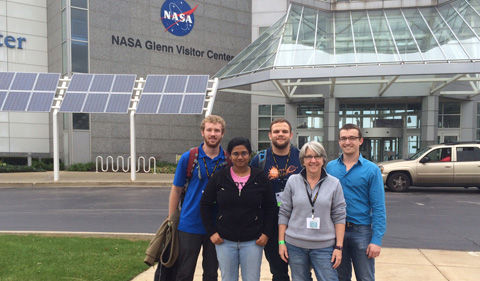
The Ohio University contingent at the 2016 meeting of the ASGSR.
Dr. Sarah Wyatt, Professor of Environmental & Plant Biology, presented a talk on “Arabidopsis proteomic responses to microgravity” as part of the GeneLab symposium at the 2016 annual meeting of the American Society for Gravitational and Space Research.
Wyatt is recognized as an expert in gravitational and space biology. Using cellular and molecular approaches, she examines how plants sense and respond to gravity. One of her experiments flew on NASA’s International Space Station in January 2015. (Seedlings Germinated on Space Station Arrive in Athens)
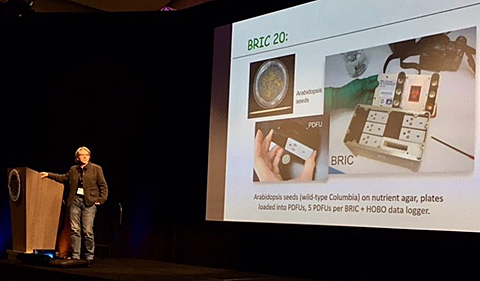
Dr. Sarah Wyatt at ASGSR
Three graduate students from the Wyatt Lab presented, two giving their first talks at an international meeting, held Oct. 26-29 in Cleveland.
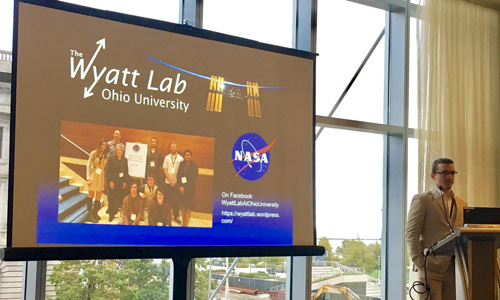
Colin Kruse gives presentation at ASGSR.
Colin Kruse presented a talk: “At the intersection: a computational approach to identify fundamental mechanisms involved in plant responses to gravity.”
Abstract: Plants (and animals) on Earth have evolved to use the ever-present stimulus of gravity as a source of information. In plants, gravity is sensed in individual cells within the root cap columella and the endodermis of the shoots, suggesting a fundamental cellular response mechanism in plants to gravity. To fully understand how plants use gravity, however, we need to understand how they grow and develop without it, and spaceflight provides us a venue to study that. And now, GeneLab provides access to omics data sets from multiple spaceflight experiments. Our primary goal is to identify key elements involved in the cellular mechanism responsive to gravity. To accomplish this, we have analyzed the intersection of transcriptomic data from BRIC 20, other gene expression data sets from the GeneLab repository and a data set from a ground-based experiment assessing gene expression across time after reorientation with respect to gravity. Each gene expression data set selected was first analyzed to determine genes differentially expressed between control and experimental groups. The resultant gene lists were then intersected to find common genes of interest. Five genes (ERF104, IQ21, MSRB6, PP2-A13 and AT4G23670) were found to be upregulated within two minutes of reorientation on Earth and downregulated under microgravity conditions or vice versa. Four additional genes (XTH24, ATL31, ATL23 and AT1G78820) were found to be differentially expressed in both microgravity data sets and exclusively in the gravisensing organs (roots and hypocotyls). Based on functional analysis of protein domains and existing annotations, five of these genes (ATL31, ATL23, ERF104, IQ21 and PP2-A13) indicate a role in cellular signaling activities. The remaining genes are likely involved in cell wall reorganization and ROS response. Determining the regulatory roles of these genes may aid in the fundamental understanding of plant gravitropism thus increasing the viability of long term space missions. If successful, the intersection approach may aid in identifying common elements in response to gravity or other complex signaling events in a variety of organism. This work was partially funded by NASA (#NNX13AM48G to SEW and DRL) with supplemental funding provided by NASA GeneLab.
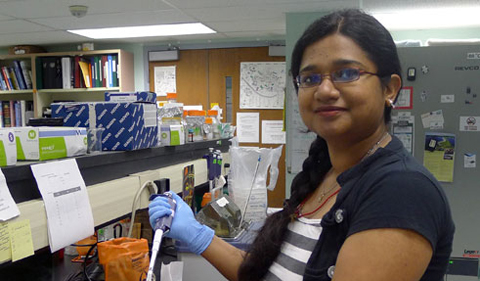
Proma Basu
Proma Basu presented a talk, ““Results from proteomic analysis of Arabidopsis seedlings germinated in microgravity”
Abstract: Spaceflight provides a salient control in the study of gravitropism. Transcriptomic studies provide a wealth of information about plant responses to microgravity, but they don’t accurately predict the functional proteins formed. Therefore, this study follows a discovery proteomics approach to compile the proteome of seedlings germinated in microgravity, Roughly 20,000 Arabidopsis Wild Type Col-0 seeds were flown aboard the International Space Station using BRIC hardware. After approximately 3 days, seedlings were fixed using RNAlater® and frozen at -80o C till return to Earth. Duplicate sets of WT Col-0 seeds remained on Earth as a ground control. Two additional sets of seedlings were used as hardware and fixative controls for the spaceflight samples in order to identify proteins which were only affected by microgravity. Membrane and soluble proteins were extracted from the plant tissue and analyzed using iTRAQ 8-plex tandem mass spectrometry at Danforth Plant Science Center. Using Mascot (Matrix Biosciences) and the TAIR10 database, 2682 soluble and 2951 membrane proteins were confidently identified in spaceflight and control samples with 163 soluble and 166 membrane proteins differentially abundant in microgravity vs ground control. Gene Ontology classification indicated 55.2 % of the soluble proteins were associated with the vacuolar protein storage and 20.2% were targeted to the endoplasmic reticulum. For membrane proteins, 44.6% were related to chlorophyll biosynthesis and 25.3% of membrane proteins were found on the lumen side of the endoplasmic reticulum. Analysis of the hardware and fixative controls identified proteins that were common among these controls and the space vs ground differentially regulated proteins. These common proteins are general stress response. Having identified the differentially abundant proteins and ones affected by general stress helps in figuring out proteins which are functional in the gravity signal transduction cascade in Arabidopsis.
This work was partially funded by NASA grant # NNX13AM48G and GeneLab supplement to SEW and DRL.
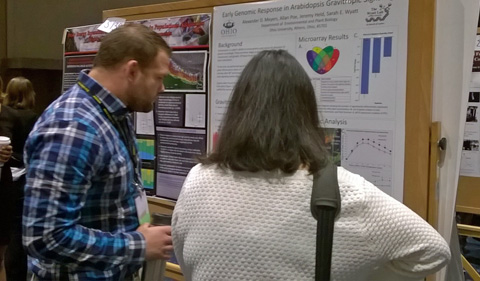
Alexander Meyers at ASGSR
Alexander Meyers presented a poster, “ Identification of differentially expressed genes in early gravitropic signaling in Arabidopsis”
Abstract: Gravitropism is a plant’s ability to sense its orientation and alter its growth relative to the direction of gravity. Upon reorientation, mechanical changes in the cell trigger a cascade of signaling events leading to the redistribution of the plant growth hormone auxin. Establishment of an auxin gradient allows differential growth and bending of the plant organ. To study the signaling events between gravity perception and auxin redistribution, plants were placed on their sides at 4 °C. Under these conditions, the plant perceives gravity and cells send the concomitant signals, but redistribution of auxin is limited and bending inhibited. When returned to vertical at room temperature, the plant bends according to its previous orientation in the cold. This delayed gravitropic response, the Gravity Persistent Signal (GPS) response, allows isolation of early signaling events from subsequent bending. Taking advantage of this, RNA was isolated from Arabidopsis inflorescent stems 2, 4, 10, and 30 minutes after reorientation at 4 °C. Microarray analysis revealed 8 genes to be differentially expressed exclusively at the 2 minute time point. The differentially expressed genes identified by the microarray were assessed by qPCR, and plants defective in each gene were assessed for altered gravitropic phenotype. These genes represent some of the earliest described genomic response elements associated with shoot gravitropism.
Partial funding for this research was provided by NSF grant IOS #1147087.



















Comments